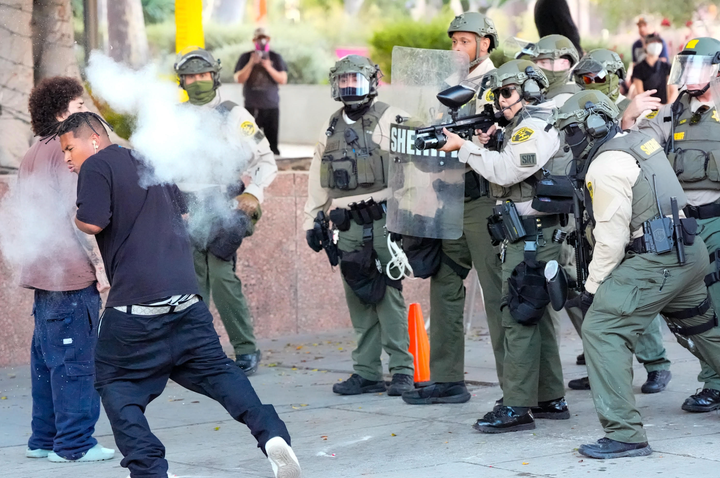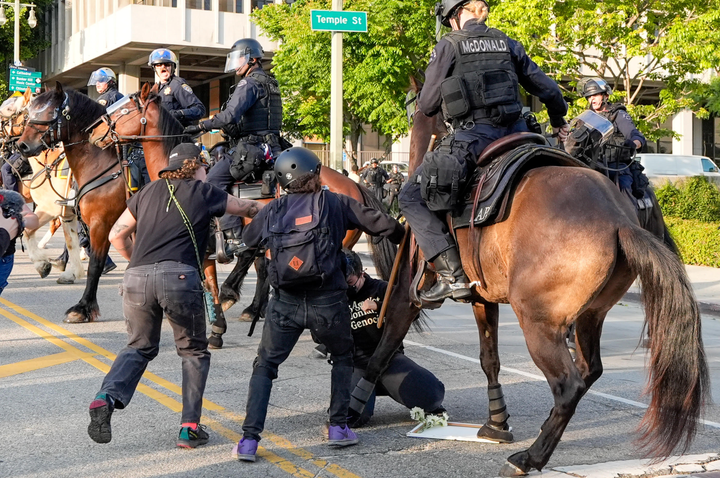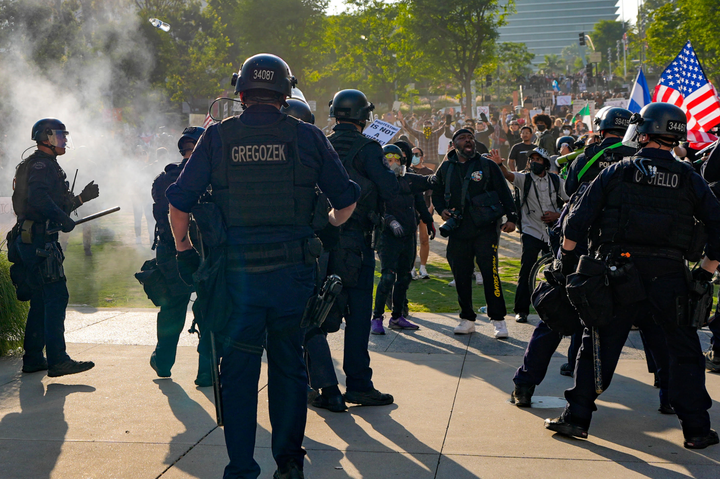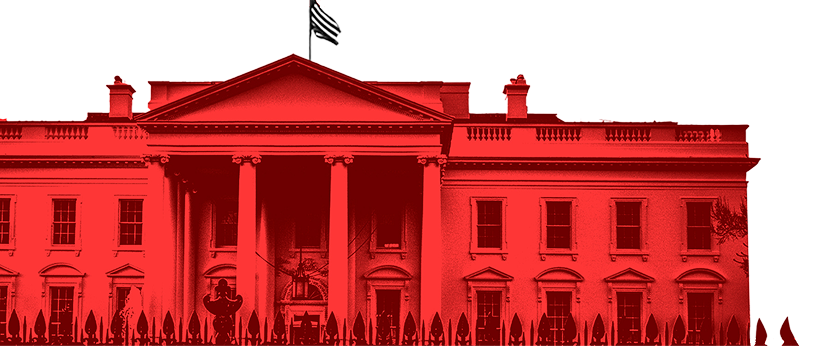
It was half an hour before curfew in Los Angeles, the light fading as the sun dropped behind the skyline, when the police shot a group of photojournalists — including me.
This was the sixth day of protests, spurred by U.S. Immigration and Customs Enforcement (ICE) executing mass arrests across the city. Angelenos came out en masse, especially at federal buildings in Downtown Los Angeles. Even with thousands of people in the streets, ICE continued its raids, pushing the nation’s second-largest city toward the breaking point.
For two decades, HuffPost has been fearless, unflinching, and relentless in pursuit of the truth. Support our mission to keep us around for the next 20 — we can’t do this without you.
Early Wednesday evening, hours before the 8 p.m. curfew, protesters gathered to march. Their flags were backlit by the setting sun, and their homemade signs were held high. The procession ended in front of City Hall, which was blocked by barricades and a single file of Los Angeles Police Department officers, fluorescent green less-lethal rifles reminiscent of Nerf guns held in front of them, standing beneath the words carved into the building: “Righteousness exalteth a people.”
The crowd was peaceful, chanting and cheering, some with megaphones, when the police stepped toward the demonstration, abruptly fired flash bangs, moved in on horseback, and started shooting.
A Black man in his 20s next to me was shot in the arm by something, and another demonstrator moved him to cover behind a street pole, pulled out a medical kit, and bandaged the bloody welt. Demonstrators and journalists were trampled in the street by horses as they tried to get out of the way of the advancing officers.
Even as police moved in and escalated, the protesters did not become violent. The most aggression I saw was one man who lobbed an open Four Loko can at a deputy sheriff. He was immediately shot, tackled, and taken away.
As it edged past 7 p.m., many protesters had already dispersed. I stood with a small group of photographers on North Hill Street in the fading light, bright blue PRESS patches on my body armor and helmet, National Press Photographers Association credentials around my neck, professional cameras in both hands. My shirt was damp against my back from sweat. Police lined the width of the block in front of us, weapons held across their chests, and the protesters had moved down toward the intersection. We journalists stood alone in the middle of the street, taking in the scene and deciding where to go next as darkness fell and police tactics shifted.
I was flanked by veteran photographers from Getty, AFP, and The Associated Press, all of whom were experienced in covering protests and civil unrest around the world. Some were even finalists for the Pulitzer Prize. No one told us to move or gave us any orders. The street crackled with a heavy, charged stillness.

In that lull, one member of the Los Angeles County Sheriff’s riot squad, the SRT, lifted his weapon and fired a barrage of PepperBalls in our direction. These paintball-sized projectiles have a hard plastic shell that shatters upon impact, releasing a cloud of powdered pepper spray designed to cause gagging, burning, and extreme discomfort. It spreads a dozen feet from the impact site and lingers in the air for up to 15 minutes.
It took a few seconds for us to appreciate that this officer was apparently shooting at us on purpose. We looked around in confusion. Were we between some violent agitator and the sheriff that we had not seen? Because we were part of the press, bearing witness to what was happening, we initially assumed that we couldn’t possibly be the intended targets. I looked at the photographer to my right, and we laughed at the absurdity when we realized what was happening.
The deputy aimed low, and the balls hit our calves and ankles or exploded on the pavement into white puffs of powder around us. It was their way of pepper-spraying us from a distance. I flashed back to being shot at with roman candles on the Fourth of July as a kid, and I danced to safety in the same way I had all those years ago — the smoke stinging my eyes, and sparks stinging my feet. It was the first time I had been pepper-sprayed outside of my high school martial arts class.
We scurried down the street, but not far or fast enough for the cop who fired a second volley to push us further back. The other SRT members stood by unfazed, dressed in their khaki uniform shirts and mismatched black sneakers, their face shields tipped up on their tactical helmets, so I could clearly see their impassive faces.
Within 15 minutes, police had kettled the street, closing in from both sides, trapping everyone — protesters and people who were just out walking in the area. As the sky grew dark, they announced that everyone currently on the block would be arrested and that they were not free to go. One woman, who appeared to be around 30, cried and tried to reason with the police. She stated that she was a city employee and was not involved in the protest. She told them she was just walking by when the cops closed in, but the officers would not let her leave. Another woman in her 60s, who appeared to be just out on the street at the wrong time, wept quietly. Members of the National Lawyers Guild — volunteer legal observers who attend protests and represent the rights of demonstrators — called the group together to explain their rights and what would happen next. The 8 p.m. curfew was still 20 minutes away.
The press has experienced police violence during the recent Los Angeles protests in a dramatic and public fashion. Australian TV journalist Lauren Tomasi was shot from behind while reporting from the scene. Photojournalists Michael Nigro and Toby Canham were both shot in the head with less-lethal rounds. Another photojournalist, Nick Stern, had to have emergency surgery after being shot by police in the leg.
Perhaps I shouldn’t be surprised. I covered Trump’s campaign last year. At each stop, I saw the raucous response he inspired when, without fail, during nearly every speech, he pointed to the press pen and called us “fake news” while complaining to the crowd about how unfair we were to him. This incited a call-and-response of audience participation, and the crowd would turn to us, yell, and shake their fists in response. That moment was always one of the most energetic points of the day.

Trump’s supporters revel in seeing the press abused. When I walk through MAGA events while working as a journalist, it is not uncommon to have people mutter — or spit — “FAKE NEWS” in my face. Since taking office, Trump has converted his attacks on the free press from a campaign stunt to gin up energy to official policy, banning The Associated Press from the Oval Office and Air Force One, barring the media from broad sections of the Pentagon, and swapping out legacy media spaces in the White House briefing room in favor of loyal influencers who peddle in conspiracy theories.
The press is an institution — along with universities, scientists, and career civil servants — that is dedicated to creating a robust and trustworthy information sphere. As Jason Stanley brilliantly argues in his book “How Fascism Works,” fascist politics seek to destroy the trust that citizens have in institutions that back a truth-based information space. By undermining that trust, an administration can more easily spread conspiracy theories and misinformation to justify its actions. All media may not be created equal, but it is afforded equal protection under the First Amendment. Threats to journalists are threats to democracy itself.
I can’t say whether the police in Los Angeles were shooting at journalists with the goal of scaring us and driving us away, if they were on edge and spoiling for a fight after days of demonstrations, or if they resented another institution flexing its power. As media members at protests like the ones in Los Angeles, we operate with a freedom that protesters do not have. We can stand between law enforcement and protesters, get up in people’s faces with our cameras, and generally, we are tolerated. If we behave like professionals, we are often treated like it.
Los Angeles’ curfew exempted credentialed media, and because of my credentials, I was not arrested with the others trapped on that block last Wednesday. It was not, however, enough to keep me from being shot. Maybe we were simply in the wrong place at the wrong time, but our credentials were visible, we were not a threat or impeding the officers’ work, and I cannot come up with any logical reason as to why they opened fire on us.
On Monday, June 16, the First Amendment Coalition sued the city and LAPD Chief Jim McDonnell for their use of excessive force against journalists. The complaint begins by noting, “Being a journalist in Los Angeles is now a dangerous profession.” I believe the violence against protesters and journalists in Los Angeles is a symptom of a democracy veering dangerously toward darkness. When journalists become targets, society loses its clearest lens on the truth.
Jen Golbeck is a professor at the University of Maryland, where she studies extremism, social media, malicious online behavior, and artificial intelligence. She writes the MAGAReport, a newsletter reporting on the far right with a focus on trends and plans for violence. She splits her time between Washington, D.C., and the Florida Keys.
Correction: An earlier version of this piece misidentified the author of “How Fascism Works.” This has been updated.
Do you have a compelling personal story you’d like to see published on HuffPost? Find out what we’re looking for here and send us a pitch at pitch@huffpost.com.

